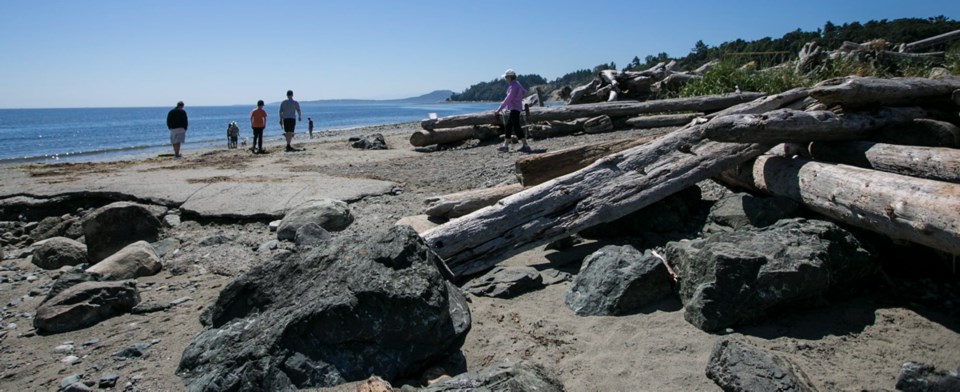‘I think we’re really close to having a plan that’s acceptable to no one, but that no one violently objects to.”
OK, not the most ringing of endorsements for the Capital Regional District’s plan for Island View Beach — particularly from the chairman of the parks committee — but, given the competing interests of park users, Mike Hicks can be forgiven for lowering the bar a bit.
After all, this process has dragged on for seven years, as long as Victoria has been squabbling about the Johnson Street Bridge. With more than 400,000 visits annually to the CRD system’s third most popular park, there’s no shortage of opinions. The beach battle is contentious enough that no solution will make all the players — swimmers, birders, campers, naturalists, the Tsawout, farmers, horse-riders, dog-walkers, dog-haters — happy.
Hence Hicks’s assessment. Or, to quote Otto von Bismarck, “Politics is the art of the possible, the attainable — the art of the next best.”
The question, for those who value Island View Beach Regional Park, is whether the next best, the plan being voted on by the CRD board July 12, is good enough.
The answer for some — sorry, Otto — is a resounding no.
The more controversial changes include fencing off a long stretch of beach and restricting access for dogs. It feels like bureaucracy run amok to those who have had free rein of the park, clambering over logs and feeling the sand between their toes, all their lives. To others, it’s a fight to maintain the park’s status as a regional conservation area, one where — officially, at least — ecological considerations trump human activity.
The most vocally aggrieved are the Friends of Island View Beach. (Officialdom should always feel nervous when it finds itself at odds with a group whose name begins with “Friends of … ”)
They’re angry about several aspects of the plan, the most visible being a proposal to build a fence separating the north half of the beach from the trail that runs alongside it. The water would be reached by just three access points. The sunbathers lolling in the sand this week would get the boot.
The idea of cutting off the beach is to foster “sand reclamation” to protect species at risk, but the Friends argue that not only does a disputed interpretation of the park’s boundary put the CRD on shaky legal ground, but winter storms are certain to wipe out the fence anyway.
Moreover, they argue the park’s environmental features have been exaggerated, not only on the beach but in inland areas that would be off-limits save for trails. They say the species the plan aims to protect don’t, and wouldn’t, exist there. What the CRD sees as natural habitat, the Friends see as former farmland overgrown with scrub due to neglect.
Indeed, part of the park was farmland as long as 150 years ago. As far back as the First World War, but mostly in the 1930s, ditches were dug to drain the water that allowed mosquitoes to breed. Flapper gates — clever devices that allowed water to flow out to the saltchuck but prevented it from flowing back in — were added to prevent flooding of the lowlands. A berm was built for the same purpose.
A 1989 ecology-based plan would have let the lowlands flood again, but Hicks said the CRD has now committed to keeping the park dry, partly out of a desire to be a good neighbour to residents and farmers who would stand to lose A) land to flooding and B) their sanity to mosquitoes. (The Friends are skeptical, saying the CRD’s commitment to maintaining the drainage system has been indifferent.)
Then there’s the dog issue. The Friends are OK with excluding dogs from the southern part of the park, but object mightily to not being allowed to walk them, leashed, along the path from the parking lot to the dog-friendly area to the north.
There’s more, but you get the gist. The Friends think of themselves as the people who know the park inside out, and of the CRD plan as being drawn up by bureaucrats acting on bad information. Calling the whole a colossal waste of time and money, they have collected 5,300 names on a petition opposing the plan.
Hicks readily concedes the Friends might be right on many points, but says nothing is written in stone. If the walk to the dog-friendly area proves too hard to navigate, if the fence can’t be built or storms wash it away, then the plan can be tweaked accordingly. Meanwhile, there are parts of the plan that have broad approval — such as the alteration of a trail to stop trespassing on Tsawout land — that need implementation. There’s no reason to believe more debate would lead to consensus on the plan’s disputed elements, Hicks says. “We could spend 20 more years on this.”
The Friends, however, say that CRD board approval of the plan July 12 wouldn’t mean the end. Gathering beside a beachside sign reading “Leave the park alone” they vowed to fight on.



